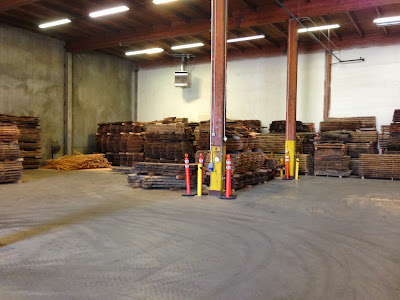It’s easy to look at a piece of furniture and admire the
design without thinking about the production process. The origin of the wood,
the cutting of the slabs, the years of drying—and that’s just pre-fabrication.
But according to Bryan Reed, general manager of Urban Hardwoods,
these steps are the most important part of ensuring the highest possible
quality for the final product.
Urban Hardwoods is a local company that handcrafts furniture
in Seattle using locally salvaged materials, 90 percent of which are sourced
within a 20-mile radius. Many of the trees come from backyards, and are labeled
as hazardous or diseased; unusable for most other projects.
“We design each piece in response to the material, highlighting the best and most interesting parts of each tree and slab," Reed says, "Our furniture is as unique as the trees that we salvage them from. Behind each piece there is a story, where it came from, and why it came down. They are stories that we and our customers feel good about.”
“We design each piece in response to the material, highlighting the best and most interesting parts of each tree and slab," Reed says, "Our furniture is as unique as the trees that we salvage them from. Behind each piece there is a story, where it came from, and why it came down. They are stories that we and our customers feel good about.”
GRAY got a step-by-step tour from lumberyard to showroom—a three-year
process that ends with stunning one-of-a-kind pieces of handcrafted furniture. We took pictures at every step to show the meticulous work that produces their products.
Raw Material: Urban Hardwoods is notified by tree services and homeowners about trees being removed. The logs are then hauled to their millard in south Seattle.
General manager Bryan Reed and operations manager Dave Hunzicker at the millard in front of a slab-cutting machine. According to Reed, the technology of the machine has changed very little in the past 100 years.
Logs being sawed into slabs.
The slabs are tagged by tree species and origin, then loaded onto a truck and taken to a warehouse to dry. "We use almost exclusively
The slabs are taken to a large warehouse about 10 minutes away where they air dry for 18-36 months depending on the thickness of the slabs and the species of tree.
Small wooden sticks (spacers) are placed between each slab to help with the drying process.
After the warehouse, the slabs go back to the millard and are put into the kiln to remove the final bits of moisture.
Once the slabs are transported to the shop, the designers make decisions about the best ways to showcase the most interesting features of the wood. The slabs are then flattened and left to rest for at least a month.
The bow tie or butterfly joint is an ancient Japanese technique for strengthening cracks in the wood.
Tables being finished in the shop.
Finished furniture in the showroom. Each piece is completely one of a kind.













An interesting and very informative article that highlights a truly unique and eco friendly product. The tables are just beautiful! They would be welcome pieces of furniture in any home or place of business for years to come. Congratulations Urban Hardwoods!
ReplyDelete